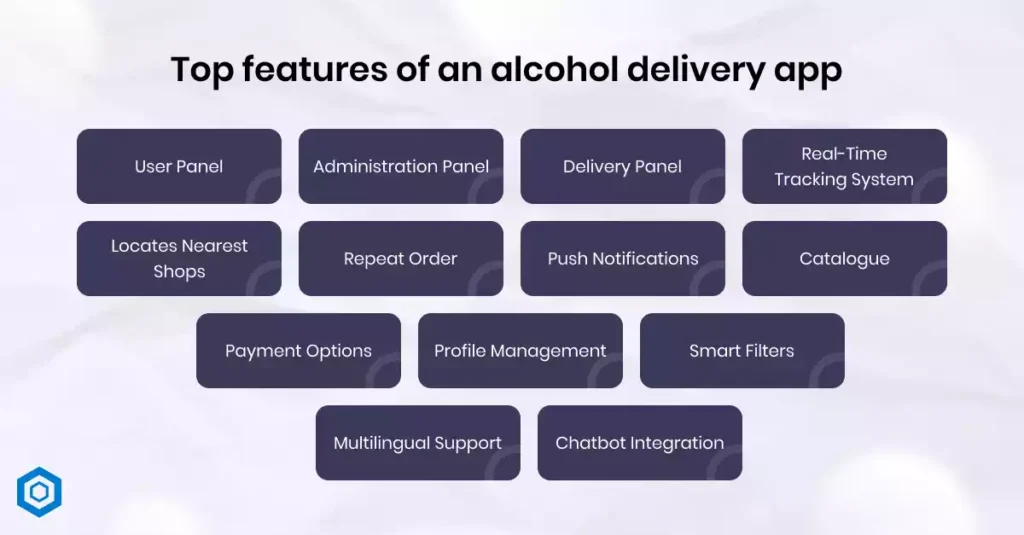
How to Build a Liquor Delivery App like Drizly
12 JANUARY
In our fast-paced world, on-demand services for takeout and groceries are sought after, driven by a need for speed and efficiency. Alcohol delivery exemplifies this recent trend. People can now purchase their favourite beverages from the comfort of their homes thanks to the popularity of the Drizzy alcohol delivery app. However, have you ever thought about building a liquor delivery app like Drizly that delivers alcohol?
You’re in luck, though! For those wishing to build their platform, several solutions are accessible due to the growing demand for booze Liquor delivery app development. When starting this road, there are many things to consider, whether you’re an alcohol delivery app developer or builder.
If you’re considering creating a Drizly-like on-demand alcohol delivery app, this post will provide a detailed primer. The essential features, required technological stack, app development costs, and revenue model will all be covered. These guidelines will help you build a profitable alcohol delivery app that serves your target market and makes money through delivery fees and commissions.
Let’s get started on a booze delivery app like Drizly!
Continue reading to learn more if you want to get into the lucrative booze delivery business.
Online Alcohol Delivery Market Size, Share, Growth
In 2018, sales of on-demand alcohol delivery applications increased by 35%, and online alcohol delivery brought in $776 million.
In the US, online liquor sales saw a 22% YoY increase, reaching $2.6 billion in 2019, driven by online grocery and alcohol marketplaces. Alcohol delivery app values increased from $3 billion in 2019 to $5.6 billion in 2020 over ten areas. Globally, e-commerce alcohol sales are projected to grow by 66% in the next five years, with alcohol delivery app sales rising by around 12% in 2019 and over 43% during lockdowns in 2020.
Approximately 6% of worldwide volume sales of alcoholic drinks are anticipated to come via e-commerce by 2025, up from 2% in 2018. By 2025, the alcohol delivery app market will be valued at over $42 billion in only 16 countries. The US online alcohol business is dominated by a small number of firms, including Drizly, Saucey, and Minibar Delivery, because of regulatory limitations.
Because there are fewer limitations, online marketplaces like Doordash offer possibilities in the alcohol delivery industry. Experts forecast that shifting customer tastes for convenience and altered consumer behaviour would cause the online alcohol market share in the United States to rise to 20% in only five years.
Alcohol Transport App On-demand booze delivery is growing due to latest trends in 2024 like millennials preferring to drink at home and customers being ready to pay more for online transactions.
The market for alcohol delivery has been continuously changing, with an increasing number of companies using online delivery strategies in addition to conventional liquor sales. Revenue can rise by streamlining processes and services using an alcohol delivery app.
Alcohol delivery applications appear to have a bright future based on current trends:
Businesswire predicts the global alcoholic beverage market will reach $1,684 billion by 2025, with a robust 2.0% CAGR from 2018 to 2025. The alcohol delivery app market will be $42 billion by 2025. Statista predicts that by 2025, e-commerce will represent close to 6% of alcoholic beverage volume sales worldwide.
The market will rise due to growing disposable income, shifting young adult demographics, and increasing consumer desire for high-end goods.
Some of the major companies in the industry include Minibar, DoorDash, Tavour, Saucey, and Drizly.
The alcoholic beverage industry was expected to generate $261.10 billion in sales by 2022. Entrepreneurs are increasingly creating alcohol delivery apps like Drizly to boost ROI. The alcoholic drinks market was valued at $1,624 billion in 2021 and is projected to reach $2,036.6 billion by 2031, with a 2.2% CAGR from 2022 to 2031 (source: Allied Market Research).
What is Drizly?
Customers may easily explore and buy alcoholic drinks online using Drizly, an on-demand alcohol delivery app. Founded in 2012, Drizly partners with local liquor stores, offering a diverse range of beer, wine, and spirits. With over a million downloads, it serves 100+ locations in North America.
Drizly has become a significant participant in the on-demand liquor delivery market as the need for on-demand and home delivery app development keeps growing. Due to its easy-to-use interface and quick delivery, people have come to prefer it.
How Does Alcohol Delivery App Work? - Business Model
The business plan for developing alcohol delivery apps by Drizly is simple and efficient. By collaborating with neighborhood businesses to offer an online platform for product sales, the organization serves as a middleman between consumers and liquor shops. Because of this, Drizly is one of the most well-liked alcohol delivery applications available, providing many items to consumers throughout North America.
Drizly has expanded its product offering to clients across North America by partnering with an extensive network of local liquor stores through its liquor delivery app development approach. Customers can expect their items to be delivered by Drizly within an hour of ordering, thanks to their incredibly efficient delivery approach.
The highly scalable commission-based model of Drizly enables.
In addition to its concept, Drizly offers mobile app development services to liquor retailers that want to build a Drizly-like app for alcohol delivery. With the help of this service, liquor retailers may create their on-demand alcohol delivery app and leverage Drizly’s technological stack to support it. Drizly is compensated with a percentage of the app’s sales.

Top Features of an Alcohol Delivery App
- User Panel:
Alcohol delivery apps must include a user panel since it is where consumers learn about and interact with the app’s features. Easy navigation and intuitiveness are essential features for every platform. Customers may place purchases, review items, monitor delivery, modify preferences, and view order history all from this panel. - Administration Panel:
With this feature’s help, the app’s owner or administrator may oversee and control its functions, such as order tracking, inventory management, user administration, and analytics. - Delivery Panel:
The delivery personnel oversees their deliveries via the delivery panel. Features like delivery confirmation, route optimization, and real-time tracking should be included in the forum. Revenue may rise, customer happiness can be enhanced, and delivery times can be shortened using an effective delivery panel. - Real-Time Tracking System:
For alcohol delivery applications, real-time tracking is a must-have feature. It lets users keep track of their orders from dispatch to delivery, adjust their schedules appropriately, and receive updates on the status and anticipated arrival timings of their deliveries. It offers clients a practical means of following their orders in real time, guaranteeing a seamless and practical delivery experience. - Locates Nearest Shops:
A function that finds the closest liquor outlets carrying the user’s favorite beverages should be included in the app. This eliminates the need to browse several stores, saving time and effort. It uses the user’s present location or search parameters to access the requested goods easily. - Repeat Order:
An alcohol delivery app’s repeat order function is essential since it allows customers to quickly and easily repurchase their preferred beverages with just a few clicks, saving them time and effort. This convenience benefits the users and increases app owners’ revenue. Customers may quickly retrieve their favorite goods or place repeat purchases by streamlining the reordering process, improving the overall user experience. - Push Notifications:
Push notifications are a valuable tool for maintaining consumer awareness and engagement. They give prompt updates on promotions, shipping statuses, order confirmations, and other pertinent data. Alcohol delivery applications may employ push notifications to tell customers of new specials, remind users about pending orders, and provide essential updates to improve the user experience on the app. - Catalogue:
Any alcohol delivery app must have a thorough inventory of accessible alcoholic beverages. It should have an easy-to-use, well-organized interface to simplify users’ traverse. Comprehensive product descriptions, precise price details, ratings, and reviews must be included in the catalog. To improve the user experience, high-quality pictures of the items should also be supplied. - Payment Options:
A crucial component of any alcohol delivery app is a thorough inventory of accessible alcoholic beverages. Customers should be able to traverse it easily thanks to its user-friendly and well-organized interface. Ratings, reviews, and correct price information should all be included in the catalogue and thorough product descriptions. Furthermore, to improve the user experience, there should be high-quality photographs of the items. - Profile Management:
Profile management is crucial, allowing users to handle personal info, addresses, and contacts efficiently. It streamlines ordering, saves time, and boosts the app’s user experience by enabling easy management of personal details, addresses, payment info, and preferences in-app. - Smart Filters:
Customers may narrow their search results based on preferences such as drink kinds, price ranges, and brands thanks to intelligent filters, which improve user experience. This feature makes navigating quick and straightforward, making it easier for consumers to find the desired goods. - Multilingual Support:
For alcohol delivery applications that want to attract a varied user base, multilingual support is an essential feature. It serves a worldwide user base by enabling interaction with the app in the user’s native tongue. The app should offer various language options to promote inclusion and enhance user experience, including English, Spanish, French, and others. - Chatbot Integration:
A rising trend in the alcohol delivery app market is the use of chatbots. Apps that include chatbots or customer support systems can help users with order-related issues, offer tailored suggestions, and answer general questions. With this tool, consumers can easily place orders, keep track of delivery, and quickly and effectively handle any difficulties they may be having. Chatbots improve customer experience by offering prompt and beneficial support during ordering.
How Do Apps That Deliver Alcohol, Like Drizly, Make Money?
Apps that supply alcohol on demand, like Drizly, make money from several sources. Typical revenue streams for these apps are as follows:
- Commission-Based Revenue:
Applications that offer alcohol on demand take a commission on each sale on their network. The commission charge % may change based on the market and the firm. The liquor shop or retailer pays this charge, a portion of the overall transaction value, in exchange for enabling the sale through the app. - Delivery Fee:
Many applications impose a delivery fee to pay for the expense of transporting the goods to the customer’s location. Different delivery fees may apply depending on the market and the customer’s distance from the store. It is not included in the commission charge and is usually determined by the app company. - Convenience Fee:
Customers can choose to have their items delivered within a specific time frame using some on-demand liquor delivery applications; this is often a speedier delivery service. In some situations, clients who select this option are assessed a convenience fee. Customers might pay an extra price to expedite the delivery of their purchases. - App Development Services:
In addition to the money they get from users and liquor stores, several on-demand alcohol delivery apps provide mobile app development services to liquor businesses that want to create their own applications. These applications assist liquor businesses in developing their delivery apps so they may compete in the market by utilizing their current technology stack and knowledge. The app developer receives a portion of the money made by the app in exchange.
These revenue sources enable on-demand alcohol delivery applications to make money while giving consumers convenience and delivery options and extending the market reach of liquor retailers.
How Much Does it Cost to Develop a Drizly Clone App?
As previously discussed, several variables might affect the cost of developing an app like Drizly. The possible expense is broken down as follows:
- App Design: $1,000 to $5,000
- App Development: $15,000 to $50,000+
- Backend Development: $15,000 to $30,000
- API Integration: $2,000 to $10,000
- Testing and Launch: $5,000 to $10,000
- Ongoing Maintenance: $5,000 to $10,000 per year
It’s crucial to remember that these cost projections are approximations that may change based on the particular needs, level of complexity, and app development team’s location. Furthermore, these figures do not account for costs that should also be considered, such as server hosting and app promotion.
Speaking with a respectable custom web app development firm or freelance web app developers who can evaluate your needs and give a customized quote to obtain a more exact app development cost estimate for a development project is essential.

How Do I Make an Alcohol Delivery App That Is Similar to Drizly?
To create an app similar to Drizly, you must take the following actions:
Step 1: Conduct Market Research:
Doing market research can help you completely grasp the liquor delivery business. Determine the most popular patterns, difficulties, and chances for uniqueness and creativity.
Step 2: Define App Features:
Ensure the UI is straightforward to use so that ordering, monitoring deliveries, and browsing items are all simple. Giving a seamless and joyful user experience is a top priority.
Step 3: Hire an App Development Company:
Locate a trustworthy mobile app development business that has built applications for on-demand delivery. Choose a company with knowledge of both the liquor delivery business and app development and a thorough understanding of your needs.
Step 4: Design User Interface:
Ensure a user-friendly interface for easy item browsing, ordering, and delivery tracking. Make a seamless and joyful user experience your priority.
Step 5: Develop the App:
Work together with your development team to get the app developed. Ensure the app fits your needs and vision by keeping lines of communication open and offering input regularly.
Step 6: Test the App:
Thoroughly test for bugs and performance issues. Gather user feedback for improvements and a better user experience.
Step 7: Launch the App:
Get ready for the app’s release in the app store(s) when it has been tested and improved. Respect the platform’s requirements and turn in all required paperwork. Create a marketing plan to spread the word about your app and draw users in.
Step 8: Partner with Liquor Stores:
Forge collaborates with nearby businesses or liquor stores to guarantee a large assortment of goods on your site. Make mutually beneficial arrangements and provide your clients with an extensive product catalog.
Step 9: Provide Ongoing Support and Updates:
Continuously monitor and maintain your app’s functionality, swiftly address any issues, ensure security, and stay competitive by frequently updating with new features and enhancements.
You may construct an app that meets the demands of consumers in the booze delivery market and is comparable to Drizly by following these steps and making a significant investment in strategy, development, and implementation.
Conclusion
In summary, developing an app similar to Drizly for on-demand booze delivery can be profitable. Conducting market research, defining the app’s features, hiring a liquor delivery app development business, creating an intuitive user interface, developing and rigorously testing the app, collaborating with liquor retailers, and releasing it on the app store are all essential for success. Developing an Alcohol Delivery App, such as Drizly, usually costs between $60,000 and $150,000, but the potential earnings and user convenience benefit the investment.
Online marketplaces are becoming more common and accessible for businesses and consumers as technology develops. Millennials have become more and more accustomed to using alcohol delivery apps, in particular, because of how convenient and easily accessible they are.
If you’re thinking about developing an app for alcohol delivery, consider collaborating with Codeflesh’s skilled software developers. We can offer you a first-rate Alcohol Delivery App Development firm that will surpass your expectations and promptly realize your business ideas. Together, let’s create your alcohol-related software.
Table of Content
Market Size and Income Model for Online Alcohol Delivery
How Does Alcohol Delivery App Work? – Business Model
Top Features of an Alcohol Delivery App
How Do Apps That Deliver Alcohol, Like Drizly, Make Money?
How Much Does Developing a Drizly-Like App Cost?
How Do I Make an Alcohol Delivery App That Is Similar to Drizly?





